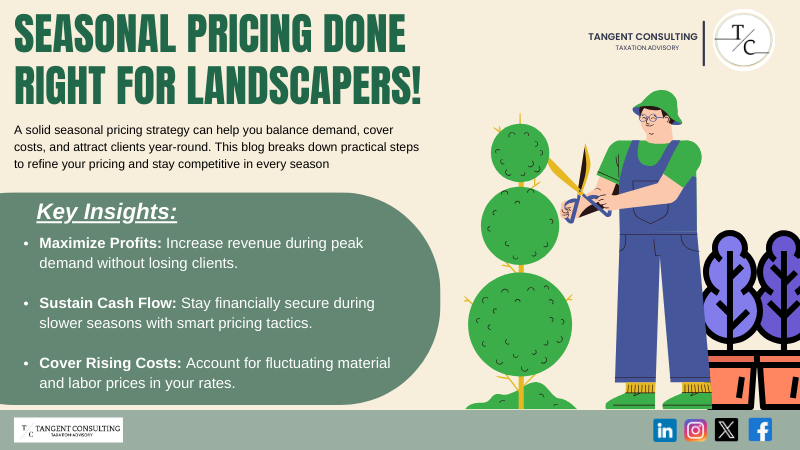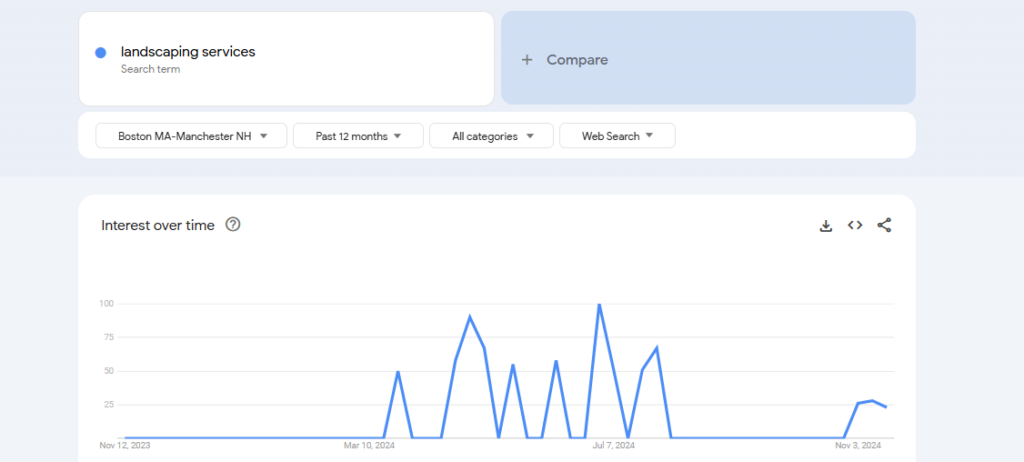How to Improve Seasonal Pricing Strategy as a Landscaper?
How to Improve Seasonal Pricing Strategy as a Landscaper?

It’s a beautiful November morning, and one of your clients called to manicure the lawn. But you are anxious, as winter is coming, and you have fewer lawns to mow, and you wonder how you can price services to stay green all year long.
If you are a landscaping business owner who can relate to the above situation, we have the perfect guide. Here, we’ll explain how you can improve the seasonal pricing strategy for your landscaping business.

What is a Season Pricing Strategy?
The landscaping industry experiences its peak revenue during late spring and early summer. The highs and lows of the landscaping calendar feel like a rollercoaster, and this is where a seasonal pricing strategy comes in. It’s about planning your pricing to reflect demand, cover costs, and keep revenue consistent throughout the year.
When demand peaks, your pricing should match the value you provide. During quieter months, your strategy might involve offering discounted services, upselling maintenance packages, or diversifying your services, such as snow removal in winter.
It’s worth noting that a seasonal pricing strategy isn’t just about setting rates—it’s about forecasting, adapting, and ensuring your business remains profitable.

5 Ways to Improve Seasonal Pricing Strategy as a Landscaper
“By failing to prepare, you are preparing to fail.” – Benjamin Franklin
Sure, Ben Franklin wasn’t trimming hedges or spreading mulch, but the man knew a thing or two about preparation—honestly, landscapers could write the book on it.
You prepare yards for storms, gardens for blooms, and lawns for every imaginable weather twist. But what about preparing your pricing strategy?
So, let’s take Ben’s advice and get prepared! Below are five practical ways to improve your seasonal pricing strategy.
1. Identify Seasonal Trends
Getting ahead is super important in a competitive landscaping niche. You need to understand when your business is performing well and when it isn’t.
To do this, you can start by identifying the seasonal trends specific to your region. When do people demand lawn care? When do they need snow removal or leaf cleanup? Your pricing strategy should mirror these trends.
After that, you need to review your records from previous years. Look for patterns in client inquiries, job bookings, and revenue spikes or dips. This can help you identify patterns and set the right pricing for your services.
Pro Tip: Use Google Trends to see when landscaping services are most searched for in your area. It’s a free way to understand demand cycles.
In the picture below, you can see we searched for landscaping services in Boston, and this is what we found.

2. Research Competitor Pricing
Now, we’re not saying you should steal your competitors’ pricing strategies—but keeping an eye on what they’re doing can give you a competitive edge. Knowing how other landscapers in your area price their services helps you position yourself in the market and avoid being under or overpriced.
To analyze competitor pricing, you can visit competitors’ websites or check their social media. You can also see what services they offer and if they offer discounts.
It’s important to note that after researching competitor pricing, you don’t have to race to the bottom; instead, focus on providing value and highlighting your unique selling points.
3. Set Your Base Rate
Landscaping involves hard work and expensive equipment. That’s why setting your base rate—the foundation of your pricing strategy, is crucial. Your base rate ensures you’re always covering your costs while highlighting the value you bring.
To set a base rate, calculate all your costs, such as labor, equipment, fuel, marketing, and others. Then, factor in your profit margins. After calculations, you can set your seasonal rates.

4. Develop a Season Pricing Strategy
You can’t set a higher price tag on spring services and call it a seasonal pricing strategy. Developing a seasonal pricing strategy involves customizing your services to meet fluctuating demand while ensuring pricing remains competitive and profitable.
This is how you can create a seasonal pricing strategy:
- Charge a premium during high-demand months like spring and early summer.
- Offer reduced rates or bundled services in the slow season to keep your crew busy and clients happy. In bundled services, you can include lawn care in spring, mulching in summer, and leaf cleanup in fall.
- Create pricing tiers that offer basic, standard, and premium options. This gives clients flexibility and allows you to upsell premium services during peak times.
5. Balance Value and Business Goals
In landscaping, giving your clients great value is essential—but not at the expense of your business’s goals. You need to strike the right balance between delivering value and achieving your goals.
Whether it’s increasing revenue by 20%, expanding your client base, or breaking into a new seasonal service, let your goals guide your pricing strategy.
A key point to add here is value doesn’t always mean lower prices. It could offer flexible payment plans, loyalty discounts, or premium services for those willing to pay extra.

Final Thoughts
Developing a seasonal pricing strategy doesn’t have to be difficult—it’s about understanding your landscaping business, planning, and delivering value.
Remember, your pricing should reflect the value to gain an edge over your competitors.
Speaking of gaining an edge, isn’t it great to set the right pricing strategy by having an expert on your side?
Tangent Consulting has years of experience working with landscaping businesses in bookkeeping, CFO services, tax preparation, and business consulting.
PS If you are reading this, it means you can have access to our free consultation for your landscaping business. Avail this for free today before we change our mind 😉
FAQs
What is the 4-pricing strategy for landscaping business?
The four key pricing strategies are cost-based (covering expenses plus profit), value-based (reflecting the service’s perceived value), competition-based (aligned with market rates), and seasonal pricing (adjusting rates based on demand).
What is the economic pricing strategy?
Economic pricing focuses on offering services at lower costs by reducing overhead expenses while maintaining profitability.
How to deal with seasonal demand?
You can adjust pricing for peak seasons, offer off-season discounts, and diversify services, such as snow removal in winter.
